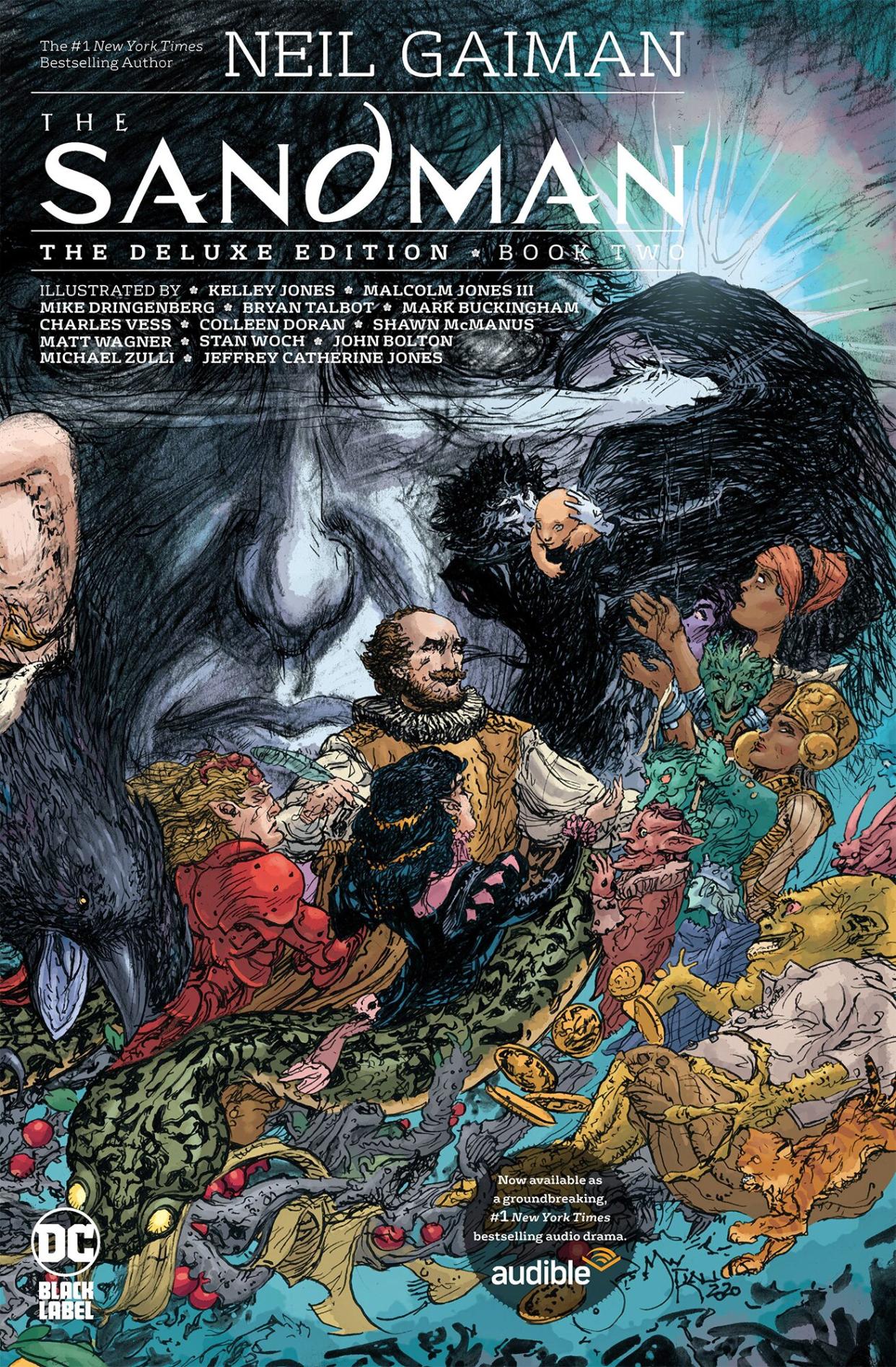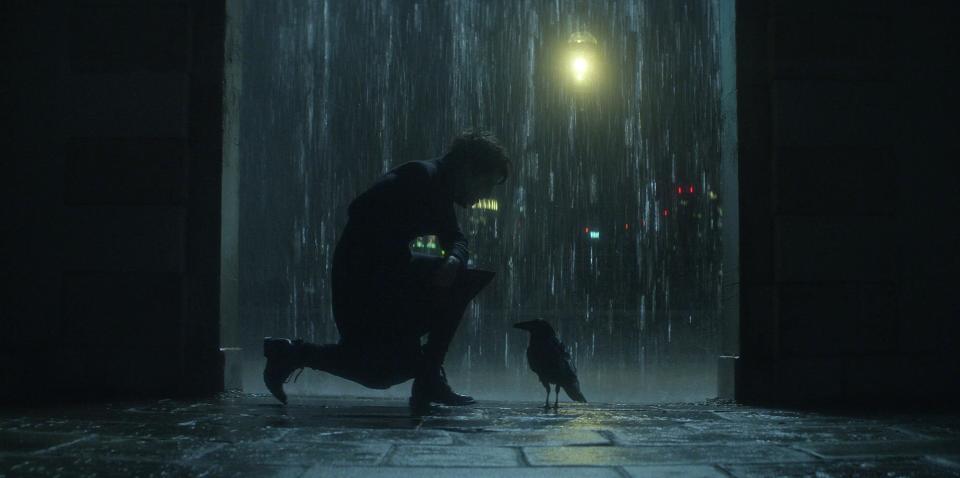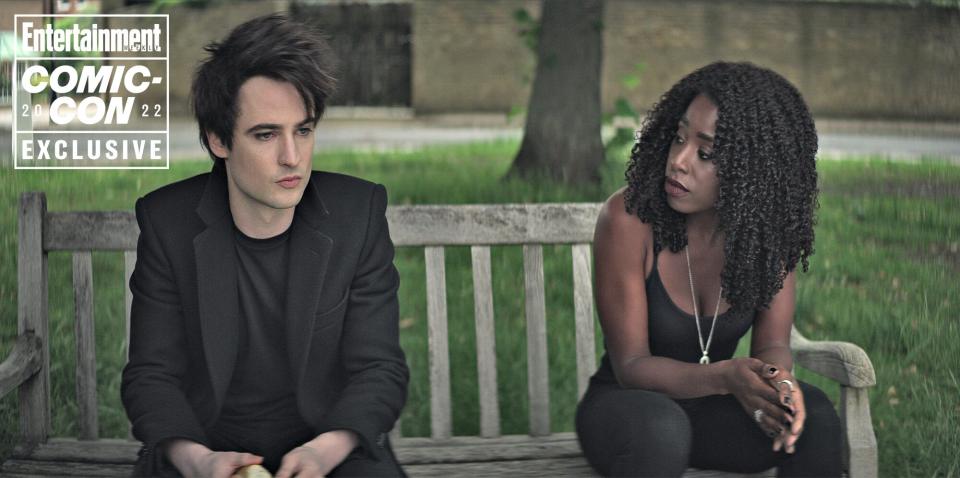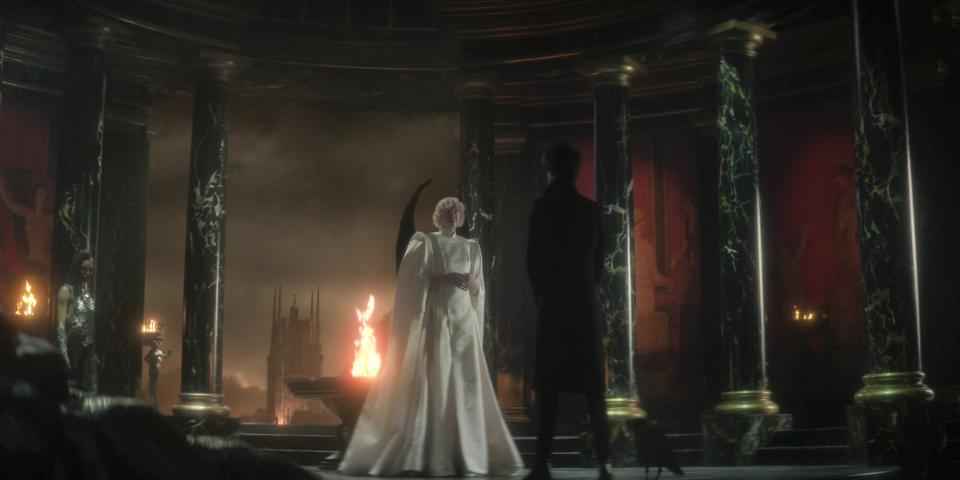Inside the 30-year journey to bring The Sandman to screen

- Oops!Something went wrong.Please try again later.
- Oops!Something went wrong.Please try again later.
- Oops!Something went wrong.Please try again later.
It's important to remember that comic books did not always have the cultural cachet they do now. Every year seems to set new sales records for comics, while every month sees the release of new movies or TV shows based on graphic novels. The Sandman (out on Netflix Friday) is the latest of these but stands out because it's an adaptation of the comic series that did more than any other to prove the format's literary worth.
Originally created by writer Neil Gaiman and artists Sam Kieth and Mike Dringenberg, The Sandman is a story about the king of dreams — which really means it's a story about stories. The protagonist, Dream of the Endless (a.k.a Morpheus, a.k.a the Oneiromancer, a.k.a the titular Sandman, played by Tom Sturridge in the show) is the sovereign of storytelling, responsible for shaping the collective unconsciousness of mortals — the things we see when we close our eyes at night, and the ideas that inspire us as we go about our lives.
"When Neil was writing the Sandman comic, he wanted to use it as a platform through which he could tell any story he wanted to tell, without getting stuck in any one genre," says Allan Heinberg, showrunner of the new adaptation.

DC The cover of 'The Sandman Book Two' collected edition.
Heinberg is a lifelong fan of The Sandman. When he first encountered Gaiman's comic as a young reader, he was fascinated because it began in the DC Universe, with which he was so familiar. Following in the footsteps of fellow British visionary Alan Moore's work on Swamp Thing, Gaiman used the well-known DC canon as a launching pad for his literary exploration of genre and storytelling. Dream's signature helm is modeled after the gas mask worn by the '40s DC superhero called Sandman, and other recognizable characters from the publisher's canon, like John Constantine, the Martian Manhunter, and the supervillain Dr. Destiny, all appear in early issues.
But eventually, The Sandman left those DC trappings behind to tell a wider range of stories, including Shakespeare's A Midsummer Night's Dream performed for the characters of A Midsummer Night's Dream; the devil deciding in postmodern fashion that he doesn't actually like his job ruling Hell; a Comic-Con-type gathering by and for serial killers; and many more. These stories, told with literary flourish by Gaiman and illustrated by talented artists, made a big cultural impact.
"It really exploded the world of comic book storytelling," says Patton Oswalt, who once waited in line for hours at San Diego Comic-Con in the '90s so Gaiman would sign his copy of The Sandman's fourth volume, Season of Mists, and now voices Matthew the Raven on the show. "But it also makes you rethink all storytelling. If you dream something, if you create another world, does that world have a life of its own? How necessary are stories for our survival?"

Netflix Morpheus (Tom Sturridge) finds a new raven companion, Matthew (Patton Oswalt), in Netflix's 'The Sandman.'
The Sandman was so big in the '90s that Laurence Fishburne's character in The Matrix is almost certainly named and styled after Gaiman's Morpheus. The aforementioned Midsummer Night's Dream issue became the first (and still only) comic book to win the World Fantasy Award for Best Short Fiction. In an equally rare feat for modern comics, The Sandman attracted a huge female readership (in an interview with The New Yorker years ago, Gaiman playfully said the series was sexually transmitted: "Guys who wanted their girlfriends to read comics would give them Sandman. They'd break up, and the girl would take the Sandmans and infect the next guy. It grew on a vector").
Many of those female readers were attracted by the well-drawn female characters like Death. Gaiman's grim reaper eschewed a cloak and scythe for a black tank top and a spunky attitude — inspiring many young goths in the process. The show's incarnation of the iconic character is played by Kirby Howell-Baptiste.
"I first read The Sandman in the late '90s as a teenage goth," G. Willow Wilson, co-creator of the now-iconic Marvel superhero Kamala Khan, said at the 2020 DC FanDome. "For me, what's interesting looking back now is that by the time I read that series, it was already part of the culture. And so I was already wearing the Death outfit without knowing what it was. So to pick up the series and be like, 'Oh, this is where this comes from,' was really interesting for me. It had a huge impact on my sense of how you tell stories in the graphic medium, of the scope of the kinds of stories you can tell, and the way that you can put a twist on legacy characters to make them relevant and fresh again for a new audience. All of those tools that I was sort of unconsciously picking up, reading that series at that age, I think have been tremendously helpful to me in my own creative life."
For her part, Howell-Baptiste tells EW that reading The Sandman comics for the first time years ago was "unlike anything I'd ever seen before. The way he paints characters and tells the story... once you start, it's really hard to stop being a fan of Neil."

Netflix Dream (Tom Sturridge) gets some big-sister advice from Death (Kirby Howell-Baptiste) in 'The Sandman.'
As you might expect from a franchise with such cultural power, there was much enthusiasm about bringing The Sandman to the screen. In an interview with EW last year, Gaiman recalled his very first meeting about a potential Sandman movie with producer Lisa Henson in 1991, when he was still in the midst of writing the series. Many other attempts followed. Pulp Fiction co-writer Roger Avary was attached to direct The Sandman at one point in the '90s; most recently, Joseph Gordon-Levitt tried to get it off the ground as a film for him to both direct and star in. But Gaiman always had the same answer when these filmmakers came calling.
"I had refused to get involved," Gaiman says. "I'd refused to write them; I refused to be the executive producer. I wouldn't do it because I knew that if I did, I would lose the only power that I had, which was to be able to speak out against a bad Sandman movie."
Gaiman continues, "Fortunately, Sandman was just too expensive for anybody to justify making. And if you're trying to make a Sandman movie, the first question is, what do you throw out? Because Sandman, by the time it was finished, is 3,000 pages of comic. So what is your movie then?"
Some of the answers that producers came up with over the years were quite harrowing, Gaiman recalls: "Roger Avery's tenure as director lasted until he took some top Warner Bros. execs, showed them Jan Švankmajer's film Alice and told them, 'When we are in the Dreaming, it will look like this.' By the time he left, his parking space had already been painted over. Then Jon Peters got hold of it and put in giant mechanical spiders. There was a version of the script, and I'll never forget the first line: 'A-ha, foolish mortals! As if your puny weapons could hurt me, the mighty Lord of Dreams, the Sandman!' And it got worse from there."

Netflix Dream (Tom Sturridge) is not happy with the state of his castle in 'The Sadnman'
Now, here we are at the end of a decades-long journey, with The Sandman finally about to hit screens in an accurate adaptation (certain episodes, like the first appearance of Howell-Baptiste's Death, are taken almost word-for-word from the original comics). What changed? For one thing, instead of indifferent producers, this Sandman was developed by passionate fans like Heinberg.
"It expanded what I thought was possible with storytelling in any form," Heinberg says. "I first read it when I was in college, as a professional actor and aspiring playwright. From the earliest days, I really wanted to be the one to adapt it. Professionally, whenever I was in the room with Warner Bros., I would always ask, 'What are you guys doing with Sandman?' And every time they would say, 'Well, it's in features now,' or 'Eric Kripke's writing it,' because at one point Eric was doing a version for the CW."
Heinberg continues, "But what ended up happening was my ABC Studios deal was coming to an end, so my agent set up a general meeting at Warner Bros. We talked about a bunch of different projects that I might be right for. Then at the very end, Susan Rovner said, 'Are there any DC projects that we haven't developed for TV that you'd love to do?' And I said, 'I'm just gonna ask you what I always ask you, which is what are you guys doing with the Sandman?' And she said, 'Oh.' And then she said, 'Do you know David Goyer? I said, 'Yeah I know David really well; we're friends.' She told me that Neil and David were working on Sandman and were about to take it to streaming services, but they didn't have a showrunner. I was like, 'Huh.' She looked at me and said, 'We'll call you.' And then by the time I got down to my car, David Goyer was calling me saying, 'Are you f---ing kidding me?'"

Netflix Lucifer (Gwendoline Christie) on Netflix's 'The Sandman.'
On top of that, Gaiman had by now learned his way around TV production after working on Starz's American Gods adaptation and acting as showrunner on the Good Omens series himself.
"What was fabulous about that was by the time that was done, I did not feel that I could be bulls----ed by showrunners anymore," Gaiman says. "Up until that time, when a showrunner would say to me, 'We can't do this because it's too expensive,' I would believe them. Now I know that if somebody says it's too expensive, what they mean is they don't want to do it."
Technology has also advanced, and viewer habits have shifted, making The Sandman easier for modern audiences to wrap their heads around.
"In the old days, the fact that Sandman was 3,000 pages of plot was a bug. Now it's a feature," Gaiman says. "The fact that it was a story for adults that was going to need a huge VFX budget, that used to be a problem, and now it's not. The other problem was that Sandman is never just one thing. It can be scary or funny, it can be historical or weird. With a long-running television series, that becomes an advantage."
The Sandman has also aged well. Its depiction of non-binary characters like Desire (Mason Alexander Park) and drag queens like Hal (John Cameron Mitchell), progressive for the '90s, now seems perfectly in tune with 2020s pop culture. Audible's recent audiobook adaptation, narrated by Gaiman himself, has become one of the most popular shows in the platform's history. Now all that remains to be seen is how viewers react to experiencing The Sandman in three dimensions.
"This was a thing that just existed in my head for 33 years, and now it's not that," Gaiman says. "The first scene we shot was Dream talking to Lucienne (Vivienne Acheampong) before he goes down to Hell. I was watching it and just thinking, this is the last generation for whom Sandman is just this thing in these panels. The ones who come after us will know what these characters look like."
The Sandman premieres Aug. 5 on Netflix. Stay tuned for more coverage on EW.
Sign up for Entertainment Weekly's free daily newsletter to get breaking TV news, exclusive first looks, recaps, reviews, interviews with your favorite stars, and more.
Related content:

